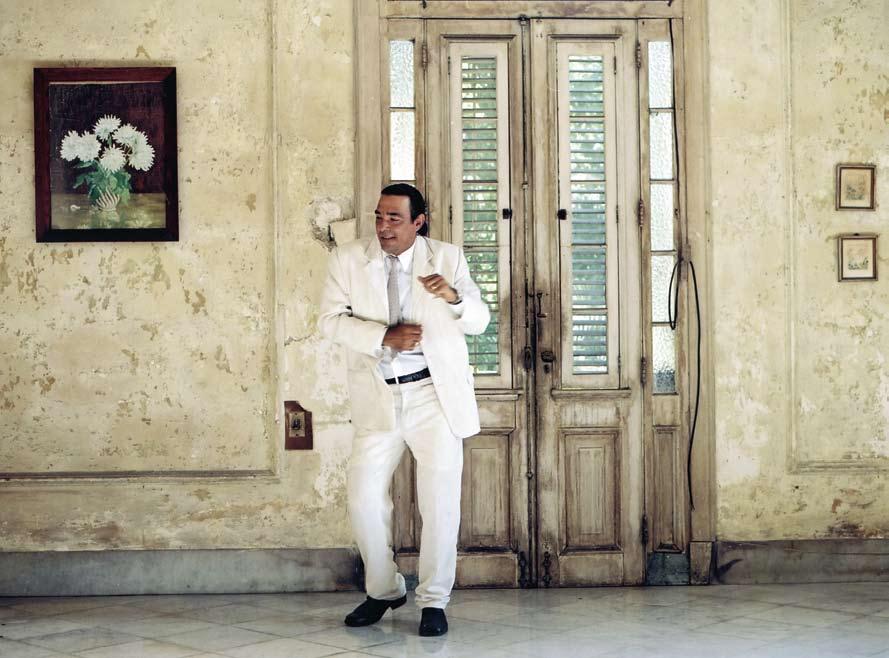Chance is a good friend of mine. I am on intimate terms with it. Chance often comes to my aid at crucial junctures. It moves things forward in small or big leaps. I sometimes get the sense of having a contract with fate. What invites chance in is my keeping a door open, allowing it in. Keeping the door of an ongoing work open is like a spell.
"I put a priority on nonsensibility, the not-right, the narrow angle of approach. Those are the conditions I want for telling my stories."
There are times when chance knows what I need better than I do. It is like a Vodou priest, a Houngan, in a long, insistent ceremony, invoking the presence of the Iwas, or spirits. They reveal themselves abruptly and with unknown force. Usually, it's not a scary but a happy thing.
Granted, all this may sound both hysterical and mystical. But hysterical it's not. On the contrary, the actual receiving situation is a sober, rational arrangement. There is nothing clandestine or ceremonial about it. There I am. I'm ready. Chance does not bring its gifts by accident. There has to be room for it and the humility to receive it. Openness is the key. On the other hand, there is something irrational about the creative process in itself.
But I go too far. That was unintended. Mainly, what I'm trying to describe is a work situation. How do you initiate a piece of work, where do you begin?
From the beginning: That was in 1963, when we made our first film, "Stop for Bud", a portrait of the jazz pianist Bud Powell. At the time, my buddy, cameraman Ole John, and I were prepared to blow up the whole film establishment. What was happening around us, for instance in the famed field of Danish documentaries, we found completely boring. Middle-class values were firmly embedded in the film environment. It was all so sensible and right. Danish filmmakers were quite skilled and that's all they were striving to be. Their professionalism was suffocating. As a starting point, we wanted to dismantle sense and calculation – all the things we considered small-mindedness – exploding cinematic conventions and reinventing the language of cinema from the ground up. Nothing less. No rules applied. Ole John and I were conspiring to turn everything upside down. Image and sound had nothing legitimately to do with each other. Image was image, sound was sound. They were independent elements.
And the whole thing about editing was a paper tiger. All that was about, after all, was putting the scenes in some kind of order, preferably determined by chance.
EMPTY WHITE SPACE, PERFECT HUMAN
Today, I can say this approach has been an alwaysvalid premise for me. I have stayed faithful to my original desire to experiment and try out new things. Not out of stubbornness but out of desire. Mainly, it's about not getting bored.
I have always wanted filmmaking to resemble poetry-writing as much as possible - to be as simple and as unpredictable. When I write a poem, I never know where it's going to end up. It starts in the upper left-hand corner and grows along unknown paths across the page. I see where it's going and I accept that. That's why I never wanted to write regular scripts for my films. For me, that would have made shooting the film a reproduction of something that had already been thought out and planned. Screenplays always look so boring with their schematic layout. One of the first films we made was "The Perfect Human". In many ways, it is a piece of writing in an empty white room. We put two people into it, with a few props and elegant clothes and a handful of very simple tasks, like a catalogue of everyday routines. Their movements and actions are studied as under a magnifying glass. The operating model is the wish to be skilled at living, to be a perfect human. We observe the surface, the skin, simple actions and discover the cracks and the small flaws in the surface, the humanity in these pseudo-anthropological situations.
The story has no conclusion. It's a (fictitious) study. That's the story. This short film is open in the beginning and it's open when it ends. In it, we are introduced to a new storytelling form that consisted of placing one scene after the other, without dramaturgy, and seeing where it went.
Salmon and potatoes with hollandaise sauce. A glass of Chablis. The perfect human in a limitless space. That was enough. Objects of microscopy. We continued this project over the years in films cultivating the clarity of tableaux. It was about creating order in chaos. In a series of films, we looked at life under a magnifying glass.
In "Life in Denmark", we stripped things down further. We didn't want any rainy weather or a social-realist mess. We simply wanted Danish life to stand out plainly and clearly, like a relief. An enamel-like surface. Emblematic.
We rendered details. We refined a style.


